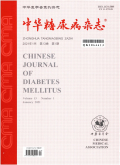无创身体测量指标识别体重正常但代谢异常人群的能力研究
Study on ability of non-invasive anthropometric indices to identify metabolically abnormal but normal weight individuals
摘要目的:评估无创身体测量指标对体重正常但代谢异常(MANW)人群的识别能力。方法:为横断面研究。选取2007—2008年中国国家糖尿病和代谢紊乱调查研究中20岁及以上常住人口中体重指数(BMI)在正常范围(18.5 kg/m 2≤BMI<24.0 kg/m 2)的人群作为研究对象。收集或计算各无创身体测量指标,包括腰围(WC)、BMI、腰高比(WHtR)、腰臀比(WHR)、体型指数(ABSI)、身体圆度指数(BRI),并将其进行四分位分组。依据BMI和代谢状态将研究对象分为体重正常且代谢正常(MNNW)组和MANW组,采用两独立样本 t检验、Mann‐Whitney U或 χ2检验对组间指标的差异进行比较,采用logistic回归模型探究各指标与MANW的关联,采用受试者工作特征曲线(ROC)的曲线下面积(AUC)评估各无创身体测量指标对MANW的识别能力及诊断价值。 结果:共纳入15 937例研究对象,其中男性5 657例,女性10 280例。整体人群MANW的患病率为22.2%(3 538/15 937)。差异性比较结果显示,MANW人群的6个无创身体测量指标均较MNNW人群升高( P<0.05)。多因素logistic回归分析显示,在校正年龄、性别、吸烟、饮酒、教育背景、民族、居住地、运动后,各身体测量指标均是MANW的影响因素( P<0.001)。在男性和女性中,ROC曲线的AUC最大的均为WHtR和BRI[男性中的AUC值(95%CI)均为0.643(0.631~0.656),女性中的AUC值(95%CI)均为0.679(0.670~0.688)]。在整体人群中,WHtR(OR=1.59,95%CI 1.53~1.66)和BRI(OR=1.56,95%CI 1.50~1.63)每升高1.0个标准差均与MANW相关。各亚组分析进一步证实了WHtR、BRI与MANW的正向关联。 结论:即使体重正常,也有部分研究对象处于代谢异常状态,且升高的BMI、WC、WHR、WHtR、ABSI和BRI均与MANW存在关联,结合应用的便捷性,WHtR可能是在临床实践和流行病学调查中筛查MANW人群的潜在有效因子。
更多相关知识
abstractsObjective:To evaluate the ability of non-invasive anthropometric indices to identify metabolically abnormal but normal weight (MANW) individuals.Methods:This was a cross-sectional retrospective study. The study population included participants aged 20 years and older with a normal body mass index (BMI) (18.5 kg/m2≤BMI<24 kg/m2) from the China National Diabetes and Metabolic Disorders Study between 2007 and 2008. Several non-invasive anthropometric indices, including waist circumference (WC), BMI, waist-to-height ratio (WHtR), waist-to-hip ratio (WHR), a body shape index (ABSI), and body roundness index (BRI), were collected or calculated and grouped into quartiles. Participants were categorized into metabolically normal and normal weight (MNNW) and MANW groups based on BMI and metabolic status. Differences between groups were compared using Student′s t-test, Mann-Whitney U test, or chi-square test. Logistic regression models were used to examine the associations between anthropometric indices and MANW. Receiver operating characteristic (ROC) curves and the area under the curve (AUC) analyses were performed to evaluate the diagnostic value of these indices for identifying MANW. Results:A total of 15, 937 participants were included (5 657 men and 10 280 women). The prevalence of MANW was 22.2% (3 538/15 937) in the overall population. All six non-invasive anthropometric indices were significantly higher in the MANW group than in the MNNW group ( P<0.05). Multivariable logistic regression analyses showed that all six anthropometric indices were influential factors for MANW ( P<0.001) after adjusting for age, sex, cigarette smoking, alcohol drinking, ethnicity, educational background, residential area, and leisure-time physical activity. WHtR and BRI had the largest AUC values in both men (AUC=0.643, 95%CI 0.631-0.656) and women (AUC=0.679, 95%CI 0.670-0.688). In the overall population, each standard deviation (SD) increase in WHtR (OR=1.59, 95%CI 1.53-1.66) and BRI (OR=1.56, 95%CI 1.50-1.63) were significantly associated with MANW. Subgroup analyses further confirmed the associations between WHtR and BRI, and the presence of MANW. Conclusions:Even among those with a normal weight, some are metabolically abnormal. BMI, WC, WHR, WHtR, ABSI, and BRI are positively associated with the presence of MANW. Given its ease of use in clinical practice and epidemiological surveys, WHtR could be a potentially effective factor for screening MANW individuals.
More相关知识
- 浏览17
- 被引0
- 下载3


相似文献
- 中文期刊
- 外文期刊
- 学位论文
- 会议论文



 换一批
换一批 换一批
换一批



